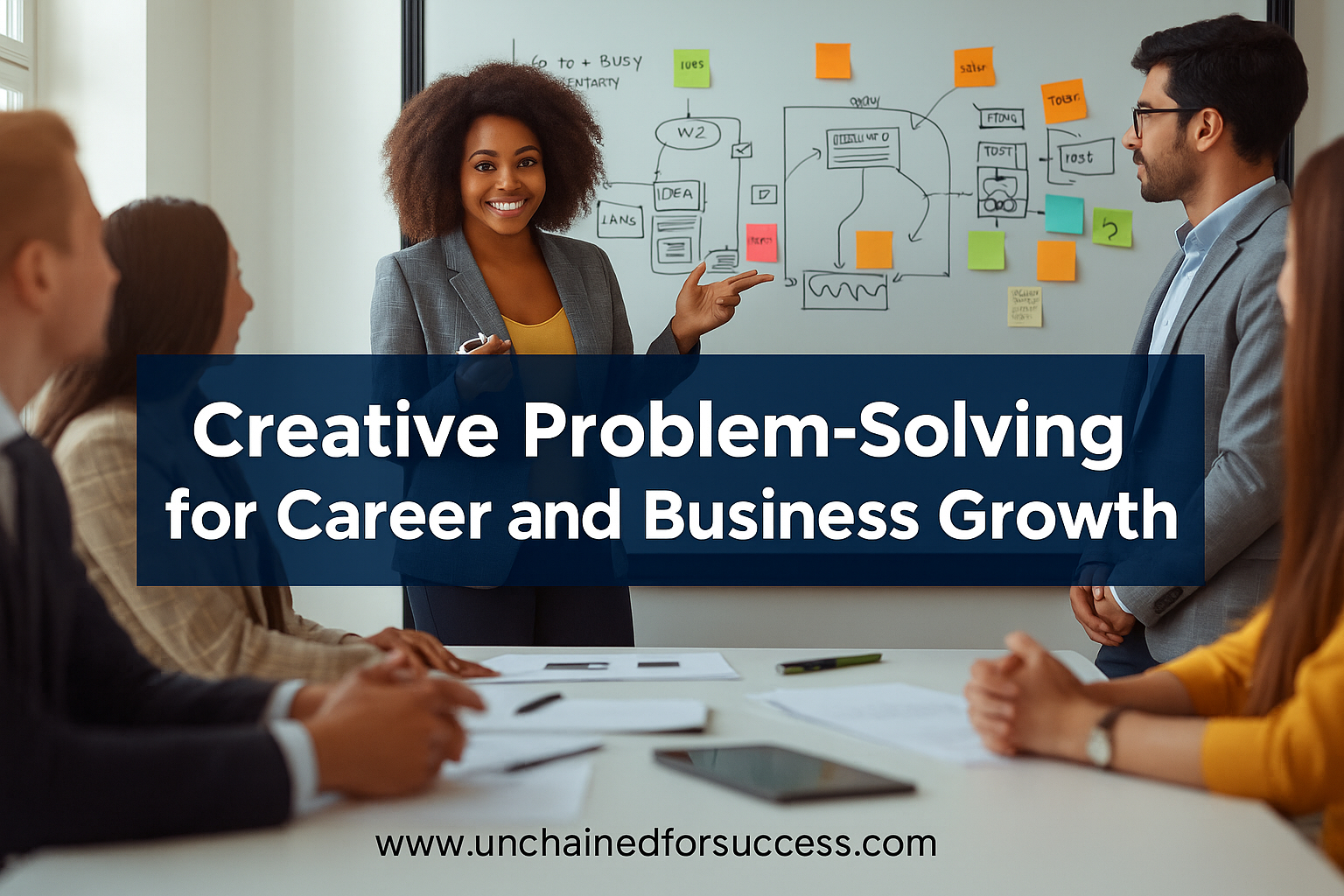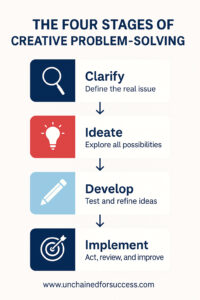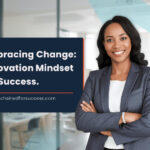Creative Problem-Solving for Career and Business Growth

Introduction: Why Creative Problem-Solving Matters
In today’s fast-changing world, creative problem-solving is one of the most valuable skills you can develop. Whether you’re a professional seeking career advancement or a business owner navigating constant change, the ability to think differently helps you adapt, innovate, and grow.
When you learn how to solve problems creatively, you discover new ways to overcome challenges, seize opportunities, and stand out in a competitive environment. For a deeper understanding of how mindset influences creativity, explore Mindset Reset: Tools to Reframe Your Thinking. It explains how your beliefs shape your ability to think beyond limitations — a key ingredient in solving problems creatively.
What Is Creative Problem-Solving?
Creative problem-solving (CPS) is a structured yet flexible process that uses imagination, analysis, and experimentation to find new solutions. It encourages you to see challenges not as barriers but as opportunities for innovation.
The CPS model, developed by Alex Osborn and Sidney Parnes, follows four stages: Clarify, Ideate, Develop, and Implement. Each stage pushes you to look deeper, explore widely, and act decisively.
For example, a project manager facing budget cuts might brainstorm cost-saving ideas before testing the most effective one. This process improves decisions and engagement because everyone contributes.
As Harvard Business Review notes, creative problem-solving helps leaders navigate uncertainty and build a culture of continuous improvement — skills vital for long-term success.
Why Creative Problem-Solving Drives Growth
Professionals and organisations that embrace creative problem-solving gain multiple advantages.
They can adapt quickly to changing demands, innovate faster, and collaborate better. As a result, they become more resilient and able to turn setbacks into opportunities.
These are the very traits described in Unchained: Success Unlocked – A Proven Framework for Achieving Your Goals, where belief systems and habits drive consistent progress. When you pair belief with creativity, you create unstoppable momentum in your career and business.
The Four Stages of Creative Problem-Solving
- Clarify the Challenge
Before searching for answers, define the real problem. Many people fix symptoms instead of causes. Therefore, ask open-ended questions like “What’s really happening here?” or “Why does this issue exist?” This reflection ensures you focus your effort on what truly matters.
- Ideate Possibilities
Brainstorm freely — quantity before quality. The goal is to explore every possible angle. Often, the most innovative solutions start as wild ideas refined later.
- Develop the Best Solutions
Narrow down your list and test top ideas. Evaluate what’s practical, cost-effective, and aligned with your vision. Gather feedback and refine your plan.
- Implement and Reflect
Turn ideas into action. Track what works and what doesn’t. Reflection completes the cycle and strengthens learning.
To explore these stages further, the IDEO Design Thinking Guide offers a helpful overview of how structured creativity can transform workplaces and fuel innovation.

Applying Creative Problem-Solving in Your Career
For professionals, creative problem-solving is a career accelerator. It helps you stand out as someone who delivers solutions, not just identifies problems.
For instance, if your team keeps missing deadlines, use CPS to spot patterns and test new workflows. This approach promotes learning, collaboration, and efficiency.
If you’re building confidence to take creative risks, read Daily Practices to Strengthen Empowering Beliefs. It shows how small, consistent habits reprogram your thinking to support bold, solution-driven actions.
Applying Creative Problem-Solving on Your Projects
Step Back to Move Forward
When a project is struggling to meet its deadline, applying creative problem-solving can be the turning point between frustration and progress. Instead of pushing harder on the same plan, step back to re-examine the challenge from a new perspective. In my experience delivering workshops through the Unchained Framework, this shift in thinking often turns the “impossible” into the “possible.”
Clarify the True Cause
The first step is to clarify what’s really causing the delay. Teams often think the issue is time or resources. However, the real problem usually lies deeper — unclear goals, broken communication, or misaligned priorities.
Using the reflective lens of the Unchained Framework, I guide teams to identify what they’re missing — whether it’s a weak belief system, ineffective habits, or lack of shared purpose. Once the root issue is visible, creative problem-solving tools such as brainstorming alternatives, mind mapping, or role-reversal exercises can generate fresh recovery ideas.
Example: Rethinking Governance for Real Progress
While supporting one organisation, we realised that several governance processes were being followed purely for compliance. Teams were ticking boxes without questioning whether each process still served its purpose. Through creative problem-solving, we revisited the intent behind each governance step — asking why it existed and whether it was relevant to the programme’s current stage.
By tailoring governance to the programme’s actual needs, we removed unnecessary barriers, improved decision speed, and rebuilt ownership. As a result, the programme moved from being weeks behind to confidently meeting its delivery milestones.
How to Apply This Yourself
- Pause and Diagnose: Step back and ask, “What assumptions are driving our current approach?”
- Engage Diverse Voices: Bring in perspectives from governance, delivery, and end users.
- Reframe the Goal: Replace “How do we meet the deadline?” with “How do we simplify delivery while keeping value?”
- Prototype Quickly: Test small workflow changes and scale what works.
- Rebuild Belief: Remind teams of their capability — belief fuels accountability and speed.
When creative problem-solving combines with the Unchained Framework, it doesn’t just fix problems; it changes how teams think. It builds clarity, ownership, and belief — the foundations of sustainable success.
Applying Creative Problem-Solving in Business
In business, creative problem-solving separates thriving companies from stagnant ones. Organisations that encourage employees to challenge assumptions, explore new models, and share ideas stay ahead of disruption.
For example, Airbnb was born from reframing an obstacle — turning unused space into income. Similarly, companies that nurture creativity often discover growth opportunities hidden in plain sight.
According to Psychology Today, creative thinking enhances both innovation and emotional resilience. These qualities help leaders navigate uncertainty and inspire their teams to keep moving forward.
Habits That Strengthen a Creative Mindset
To maintain creativity long-term, practise these habits daily:
- Ask “what if” questions to challenge routine thinking.
- Journal your ideas to capture insights and lessons.
- Seek diverse perspectives by engaging beyond your comfort zone.
- Create quiet thinking time to let ideas connect naturally.
Over time, these habits build flexibility and self-trust — foundations of creativity that also reinforce the belief pillar within your Unchained goals framework.
Overcoming Barriers to Creative Problem-Solving
Even creative thinkers face barriers such as fear of failure, perfectionism, or limited resources. To overcome them:
- Reframe failure as feedback — every misstep offers learning.
- Adopt a growth mindset to stay curious and persistent.
- Start small to create momentum through early wins.
- Collaborate often — ideas multiply in open discussion.
These simple shifts boost creativity, confidence, and consistency, turning challenges into stepping stones for progress.
Conclusion: Creativity Is the Currency of Growth
Creative problem-solving is more than a method — it’s a mindset for thriving in change. When you apply it consistently, you expand what’s possible for your career, your projects, and your business.
Every challenge becomes a chance to innovate. Every setback becomes a source of insight. Start practising one of these methods today, and you’ll soon discover that your ability to create solutions is your greatest asset.
References
- Kwegyir-Afful, C. (2023). Unchained: Success Unlocked – A Proven Framework for Achieving Your Goals.
- Harvard Business Review. How to Be a More Creative Problem Solver at Work.
- IDEO U. Design Thinking: A Framework for Innovation.
- Psychology Today. Creativity and Problem Solving in Workplaces.




